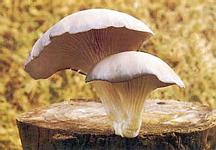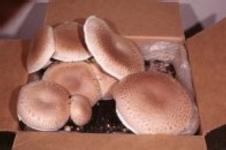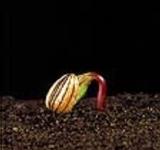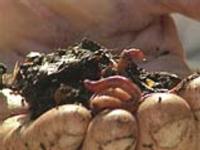|
Organic
Gardening Tips
Terra Viva Organics
Website
Update
Low
Cost Mushroom Production at Home
Preparing
for Seed Saving
The
Buzz About Worm Castings
Gingered
Asparagus
by Arzeena
Hamir

Gourmet mushrooms like
Shiitake, Oyster & Enoki mushrooms are growing in
popularity but the retail price for many of these delicacies
can often be out of range for most people. Mushroom
lovers on a budget have another option – growing mushrooms
at home.
Mushroom production might
seem complicated but there are many kits on the market
that make growing mushrooms easy. These kits provide
the substrate, pre-inoculated with mushroom mycelia
and simple instructions.
Mushrooms
When we think of mushrooms,
we often think of the soft caps & stems that we
see in the grocery store. Hidden underground, however,
is the vast majority of the mushroom mass itself- the
network of feathery mycelia. These mycelia, often seen
when turning over compost, are what the mushroom uses
to absorb food & moisture. The cap & stem that
we commonly eat is just the fruiting body.
To grow, mycelia require
an uncontaminated food source, free from other microorganisms,
moisture, and temperatures between 60-80F. The food
source can vary, depending on the species of mushroom,
from sawdust & shavings to manure or compost. Once
mycelia have colonized a food source, they begin to
produce fruiting bodies, commonly referred to as pins.
As the pins mature, they develop into recognizable mushrooms.
Kits
Most commercially available
kits range in price from $20-$30. The most common species
available in kit form are regular button mushrooms and
portabellos (Agaricus species), shiitake, and oyster.
Most kits will start fruiting within a week and you
can expect a harvest of 1-2 pounds of mushrooms per
flush. Commonly, each kit will provide 2-3 flushes of
mushrooms before the food supply is spent. Finished
kits can then be placed on the compost pile where you
can sometimes get a bonus flush of edibles.
Types of mushrooms
Shiitake mushrooms (Lentinula
edodes), have a rich, meaty texture. The brown caps
often grow up to 3-4 inches in diameter. They have been
highly prized in the Orient for centuries and scientists
are researching its medicinal, anti-viral properties.
Indoors, the kits can be stored from 55 to 75F and will
produce 2-3 pounds within 3 months.
Oyster mushrooms (Pleurotus
spp) are named for the fact that their flavour &
texture resembles oysters. The mushroom itself comes
in different colours, depending on species, from pink,
cream, white & gray. The white mushroom is the easiest
to grow and will fruit over a wide temperature range
from 55-75 F. These mushrooms are particularly sensitive
to humidity and need to be misted 2-3 times per day.

Few people realize that
the common white cap, crimini & Portobello mushroom
are all related (Agaricus spp.). Crimini are smaller,
brown mushrooms while portobellos are quite large (up
to 6″ in diameter). Growing these types of mushrooms
takes a little longer but they don’t require sunlight
to grow and will yield more than other kits, 3-6 pounds
over 3 months.
Procedure
Once a kit arrives, it
should be free of any different coloured molds. If you
do see anything strange, get a replacement. An incubation
period is required for the mycelia to colonize the whole
substrate. The kit should be kept at the proper temperature
and should be kept moist at all times. Colonization
usually requires 7-10 days.
After this period, the
mycelia need to be forced into fruiting, usually by
placing the kit in the refrigerator. Afterward, the
kit will have to be opened and exposed to some light
(excluding Agaricus species). A good place to keep the
kits is in a garage or a sheltered place outdoors. Keeping
the kits under your sink usually results in fungus gnats.
If outdoor temperatures dip, a Styrofoam cooler makes
an excellent humidity chamber, insulating the kit against
cold temperatures.
As the fruiting bodies
appear, the humidity needs to be kept high. Most kits
come equipped with a plastic tent so a regular spray
of water is enough to achieve the right conditions.
Using the right water, however, is critical. Spring,
well or rainwater is best, as it doesn’t contain any
chlorine. If none of these are available, leave a bucket
of water to stand overnight to allow the chlorine to
evaporate.
Outdoor production
If you become hooked on
mushroom production, you can move on to the next step-
growing mushrooms on logs. While logs take much more
time to develop edible mushrooms, they produce for up
to 4 years and are even more economical than the kits.
Resource Books
Growing Gourmet and Medicinal
Mushrooms, by Paul Stamets
The Mushroom Cultivator,
A Practical Guide to Growing Mushrooms at Home, by Paul
Stamets and J.S. Chilton
Websites
The Mushroom Council-
http://www.mushroomcouncil.com/
Mushroom Harvest http://www.seedman.com/rachel/harvest.htm
Puget Sound Mycological Society – http://www.psms.org/
This article was originally
published on Suite101.com.
by Sharon
Hanna

I like to think that humans
are still relatively in touch with their native abilities
to create food. I have had a hankering to collect seeds
since I was little, and I’ve seen children do it year
after year – so for me seed-saving is a lot of fun,
and just a natural thing to do.
“Open pollinated” seeds
(sometimes abbreviated to “O.P”) have not been crossed
with anything else. These seeds can be saved and will
normally produce a reasonable facsimile when you sow
them, and you can keep saving OP seed for growing the
following year. Of course, mutations do occur, even
though your back yard is not a laboratory. It’s one
of life’s mysteries for you to enjoy – and that is how
hybridization started in the first place.
Seeds which you buy in
a packages marked “F1” or “F2” (first, or second generation)
are called hybrid seeds. If you prefer to use hybrid
seed, you’ll need to keep buying them when you run out.
The seed which is produced from hybrids may be sterile,
or may have reverted, which means they have returned
to the qualities of either parent. Or, no proper seeds
will form at all.
There are as many different
ways to store seeds as their are gardeners. Some people
think freezing seeds is the answer. Some prefer to keep
them in the fridge. Some keep them in the basement,
some sealed, some not sealed.
I do not practice the
freezing method. The reason for this is simple. If my
freezer breaks down, which is a possibility because
of power outages in a wind storm, say..my seeds would
thaw. At that point, they would lose a lot of their
efficacy, since storing seeds is about the temperature
remaining about the same over the period you are storing
them.
Different approaches work,
but common to them all is consistency of temperature
and lack of humidity. Okay, I will readily admit
to keeping seeds all over the place. I may have been
a pack rat in my past life – and still my germination
rates are good on seeds I have kept for years. So the
bottom line is keep them dry, and the humidity and temperature
relatively consistent, and you should have no problem.
Individual types of seed,
however, do have a ‘shelf life’. Spinach, for instance,
is not a good keeper. But beans, peas, and many other
large seeds can last for years. It seems Mother Nature
has quite the sense of humour – weed seeds have been
know to last for upwards of 30-40 years!
All seeds are living organisms.
However corn, bean, and pea seeds actually breathe.
Avoid suffocating them in a sealed plastic container.
Sharon Hanna is a garden
writer and avid cook. Read her latest articles on Themestream
by Don Trotter

Hello fellow Earthlings,
and welcome, once again to the undersoil realm of the
fantastic earthworm. In this discussion we will be touching
on some of the many benefits of using earthworms and
their casts (politically correct term for poop) in the
garden.
Earthworm
castings have been used for centuries to increase
the quality of soil and to improve the overall health
of plants growing in that soil. Aristotle, the philosopher,
called them “The Plows of the Earth,” Charles Darwin
spent a great deal of time looking at and studying these
amazing creatures. The net result of all this fuss about
wigglers was that they became revered as the most helpful
and beneficial organisms in any garden or on any farm
or nursery where plants are grown directly in the ground.
Today, many of us don’t have the space or the inclination
to make an attempt at worm or “vermi” composting so
we go directly for the castings, which are sold at garden
centers and nurseries all over the country. Worm castings
have hit the mainstream because gardeners are finding
out that they do so much more than just improve their
soils.
Worm casts are digested
organic matter that has been run through the gut of
the earthworm. They are one of the most stable sources
of organic matter for the garden and the biology they
support is unlike that of any regular commercial or
home made compost. Earthworms impart into their casts
an incredible diversity of hygienic microorganisms that
work to competitively exclude disease-causing organisms
as well as a number of destructive pests such as root
knot and root lesion nematodes. Worm castings have recently
been discovered to fight other pests on plant surfaces
also through an ingenious little enzyme known as chitinase.
Chitinase is a degrading
enzyme that eats the material chitin. Here is the fun
part.pest insects are made of chitin. Chitinase is formed
by several types of microorganisms that are found in
the gut of the humble earthworm. Chitinase producing
organisms are theorized to be taken up by plant roots
in the water they utilize and are then moved throughout
the plant via vascular tissue. This translocation results
in chitinase being distributed into the leaves and other
parts of the plant. When a pest insect such as an aphid,
mealybug, whitefly, or any other plant-feeding insect
begins taking juices from a plant with chitinase in
it they find out the hard way what chitin degrading
means. The chitinase works to dissolve the insect’s
stomach lining thus disabling the pest. It dies from
the fact that its insides are being slowly dissolved.
There can be no more effective way to control pest insects
on plant that this method because insect pests cannot
change what material makes up their bodies. And it is
very difficult in nature to develop resistance to things
that eat you.
Earthworm castings also
have the added benefit of being loaded with other beneficial,
hygienic microorganisms that will help your plants fight
such regular maladies as powdery mildew, rust, black
spot, and a number of other fungal pathogens through
competitive exclusion. Competitive exclusion is the
process by which one species dominates and eventually
excluded another from surviving. With worm castings
you get so many beneficial organisms that the pathogens
do not stand a chance of survival.
When applying worm castings
to the garden, it should be known that the best place
for them is where your plants do the majority of their
feeding, the dripline. Worm casts should be applied
in a ring of about three-quarters to one inch in thickness
around the dripline of your plants for maximum insect
and disease repellency. This ring should be in the form
of a band of between six inches to two feet wide depending
on whether you’re using it on smaller shrubs or trees.
A layer of organic compost over the top of the casts
will help to keep them moist and protect them from the
sun depleting their biology, which is sensitive to the
rays of the sun.
So the next time you are
cursing your poor soil quality, raving at your pest
infestations, or lamenting the outbreaks of fungal diseases
in your garden, reach for some earthworm
castings. With a little patience you’ll see the
amazing effect of the lowly earthworm on your precious
gardening spaces. Next time we’ll be discussing shade
trees and their value in the landscape. See you in the
Garden!
Got Questions? Email them
to the Doc at Curly@mill.net
Don Trotter’s natural gardening columns appear nationally
in environmentally sensitive publications. For more
gardening tips check out Don’s books Natural Gardening
A-Z and The Complete Natural Gardener at bookstores
near you and all on line booksellers, both from Hay
House publishing www.hayhouse.com

|

